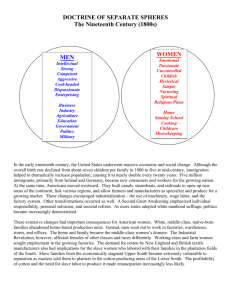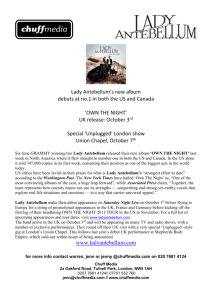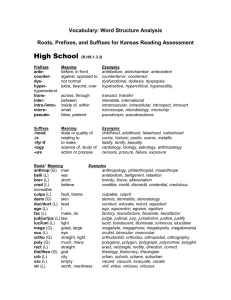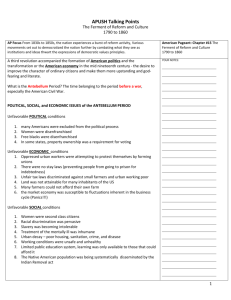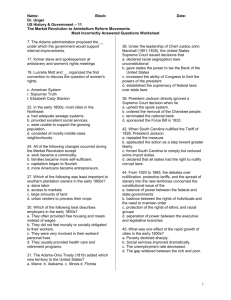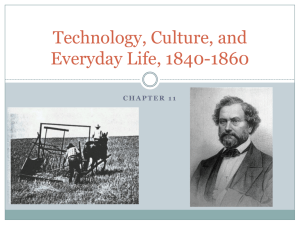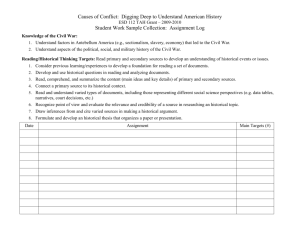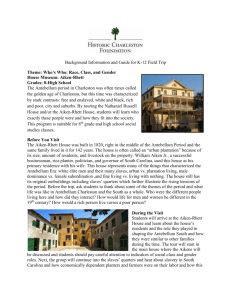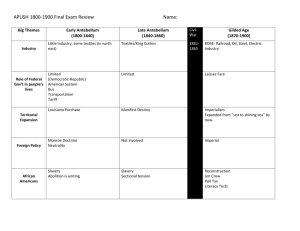The Antebellum Women's Movement 1820 to 1860 The Antebellum
advertisement
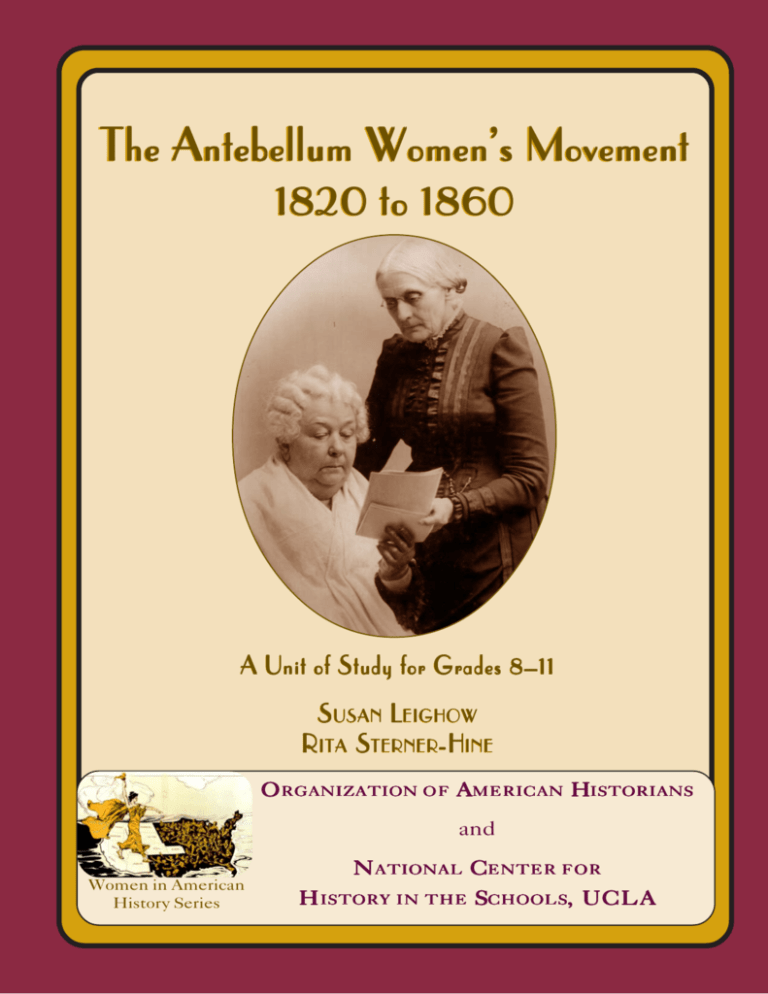
The Antebellum Women’s Movement 1820 to 1860 A Unit of Study for Grades 8–11 S USAN LEIGHOW R ITA STERNER-HINE O RGANIZATION O F AMERICAN HISTORIANS and Women in American History Series N ATIONAL CENTER F O R H ISTORY I N THE SCHOOLS, UCLA NATIONAL CENTER FOR HISTORY IN THE SCHOOLS University of California, Los Angeles This pdf was prepared exclusively for preview purposes and may not be resold or redistributed. Thank you for your cooperation! To purchase copies: nchs@history.ucla.edu Table of Contents Introduction Approach and Rationale. . Content and Organization . . . . . . . . . . . . . . . . . . . . . 1 1 . . . . . . . . . . . 3 4 4 5 6 x 8 Teacher Background Materials Unit Overview . . . . . . . . . . Correlation to the Standards for United States History Unit Objectives . . . . . . . . . . Lesson Plans . . . . . . . . . . . . Introduction to Antebellum Women, 1820–1860 . Dramatic Moment . . . . . . . . . . . . . . . . . . . . . . . . Lessons Lesson One: The “Separate Spheres” and “Cult of True Womanhood”Doctrines . . . . . . . . . Lesson Two: Women’s Work Outside Their Homes . . . . Lesson Three: Antebellum Temperance and Abolitionist Movements . . . . . . . . . . . . . Lesson Four: The Antebellum Women’s Movement . . . Select Bibliography . . . . . . . . . . . . . . . 9 26 41 53 67 TEACHER BACKGROUND MATERIALS I. UNIT OVERVIEW T his unit introduces students to the pre-Civil War women’s movement through primary source documents. The documents are grouped into four separate but interrelated categories. Those in Lesson One describe the economic and cultural systems of the United States between 1820 and 1860 which created both a “doctrine of separate spheres” and a “cult of true womanhood.” Lesson Two examines the lives of American women who worked outside the home. The documents of Lesson Three analyze women’s roles in antebellum reform movements such as abolition and temperance, experiences which later served as catalysts for the women’s rights movement. Finally, Lesson Four addresses the grievances, goals, and social impact of the female reformers who attended the Seneca Falls Convention of 1848 and wrote the “Declaration of Sentiments.” Since antebellum women of various races, classes, and regions had widely divergent experiences, various perspectives are presented throughout the unit. Comprehending the lives of American women is fundamental for understanding the entire antebellum period. At a time in which females were encouraged to be pure, pious, domestic, and submissive, women’s roles reached outside the home and family. Young New England farm women provided the bulk of the labor for the expanding textile industry. AfricanAmerican slaves, female as well as male, produced the cotton spun and woven in mills, both in the North and abroad. Middle-class, northern matrons championed diverse causes such as abstinence from liquor and the abolition of slavery. As female roles changed, women’s rights advocates became aware of the gender inequities present in their society, chafed under these limits, and established a movement which is still with us today. Lessons One and Two can be taught as students begin studying the Second Great Awakening and the Industrial Revolution. These documents will help students better understand how changing religious beliefs and new ways of producing and marketing goods affected the roles and status of black and white, middle-class, working-class, and slave women. Lesson Three may be introduced later, as students learn about the problems associated with industrialization, growing sectional tensions, and various antebellum reform movements. Teachers can conclude the unit with Lesson Four. Students can then analyze how the aforementioned forces encouraged antebellum women into launching a women’s rights movement. 3 TEACHER BACKGROUND MATERIALS II. CORRELATION TO THE NATIONAL STANDARDS FOR HISTORY Antebellum Women’s Movement, 1820 to 1860 provides teaching materials to support National Standards for History, Basic Edition (National Center for History in the Schools, 1996). The unit specifically addresses Standards 2A and 4C of Era 4, Expansion and Reform (1801-1861). Lessons in this unit have students investigate how slavery and the northern factory system affected the lives of women; examine the activities of women in the reform movements for education, abolition, temperance, and women’s suffrage; and analyze the goals expressed in the Seneca Falls “Declaration of Sentiments.” The unit likewise integrates a number of Historical Thinking Standards such as analyzing cause-and-effect relationships, identifying the central questions in historical narratives, and supporting interpretations with historical evidence. III. UNIT OBJECTIVES 1. To describe how the Industrial Revolution led to changes in women’s roles both within and outside the home. 2. To explain how economic and cultural change created a “separate spheres” ideology and “cult of true womanhood.” 3. To evaluate how the “cult of true womanhood” affected women’s influence in both their homes and the larger society. 4. To analyze women’s roles in antebellum reform movements such as temperance and abolition. 5. To compare and contrast the differing experiences of women of various racial, social, and regional groups. 6. To analyze and evaluate the impact of the antebellum women’s rights movement on American society, past and present. 4 TEACHER BACKGROUND MATERIALS IV. LESSON PLANS 1. The “Separate Spheres” and “Cult of True Womanhood” Doctrines 2. Women’s Work Outside Their Homes 3. Antebellum Temperance and Abolitionist Movements 4. The Antebellum Women’s Movement Woman’s Holy War Library of Congress 5 TEACHER BACKGROUND MATERIALS V. INTRODUCTION TO THE ANTEBELLUM WOMEN’S MOVEMENT I n the early nineteenth century the United States underwent massive economic and social change. Although the overall birthrate declined from about seven children per family in 1800 to five at mid-century, immigration helped to dramatically increase population, causing it to nearly double every twenty years. Five million immigrants, primarily from Ireland and Germany, became new consumers and workers for the growing nation. At the same time, Americans moved westward. They built canals, steamboats, and railroads to open up new areas of the continent, link various regions, and allow farmers and manufacturers to specialize and produce for a growing market. These changes encouraged industrialization—the use of machinery, wage labor, and the factory system. Other transformations occurred as well. A Second Great Awakening emphasized individual responsibility, personal salvation, and societal reform. As more states adopted white, manhood suffrage, politics became increasingly democratized. These extensive changes had important consequences for American women. White, middle-class, native-born families abandoned home-based production units. Instead, men went out to work in factories, warehouses, stores, and offices. The home and family became the middle-class woman’s domain. The Industrial Revolution, however, affected females of other classes and races differently. Working-class and farm women sought employment in the growing factories. The demand for cotton by New England and British textile manufacturers also had implications for the slave women who labored with their families in the plantation fields of the South. Slave families from the economically stagnant Upper South became extremely vulnerable to separation as masters sold them to planters in the cotton-producing areas of the Lower South. The profitability of cotton and the need for slave labor to produce it made emancipation increasingly less likely. In this rapidly changing society, Americans sought an area of stability. The separation of work and home, along with the psychological need to preserve an ideal family, led to a belief that men and women lived in separate but complementary spheres. Aggressive, rational, enterprising men were best suited for the rough-and-tumble, sometimes sordid, public worlds of business and politics. Women, who were by nature gentle, emotional, and sensitive, belonged in the private world of the home. There, they provided a haven for husbands and children from the rigors of modern capitalism. Those who espoused these views wrote and published a wealth of proscriptive literature urging “true women” to be pious, pure, submissive, and domestic. Although the “separate spheres doctrine” and the “cult of true wom6 TEACHER BACKGROUND MATERIALS anhood”1 held little validity for working-class, immigrant, and AfricanAmerican women, this cultural ideal pervaded antebellum society. “The cult of true womanhood” both empowered and limited women. Educational opportunities expanded as reformers like Catharine Beecher argued that American wives and mothers needed more schooling in order to properly rear sons and influence husbands. This same reasoning opened up teaching as a suitable occupation for females who were morally superior to men, as well as innately fitted to deal with children.2 Women’s piety, morality, and concern for their families also provided the impetus for their involvement in antebellum reform movements. At the same time, males in medicine, law, and the ministry barred women on the grounds they were “too delicate.” States’ legal system did not always protect wives’ rights to their property, wages, or children. Even within the temperance and abolition movements, men tried to constrain women’s activities. In her 1852 letter to Amelia Bloomer, Susan B. Anthony complained about male colleagues who did not believe “. . . that women may speak and act in public as well as in the home circle . . . .”3 By the 1840s a nascent women’s rights movement emerged. By then, American females had perceived the inconsistencies between their alleged superiority and their very real powerlessness. Education gave them the ability to articulate their problems and propose alternatives. Their reform activities provided them with the ideologies and skills necessary to establish this cause. The documents and lessons in this unit provide the resources necessary to understanding this antebellum women’s movement that would set women on a course leading in zigzag fashion to modern feminism of the late twentieth century. 1 Barbara Welter originated the phrase “cult of true womanhood” in an article published in the American Quarterly in 1966 (“The Cult of True Womanhood: 18201860,” Vol. 18 (2:1), 151–74. 2 School boards hired more women as teachers; however, their pay was one-third to one-quarter that of a male teacher. 3 Ellen Carol DuBois, ed., The Elizabeth Cady Stanton-Susan B. Anthony Reader (Boston: Northeastern University Press, 1981), 40. 7
